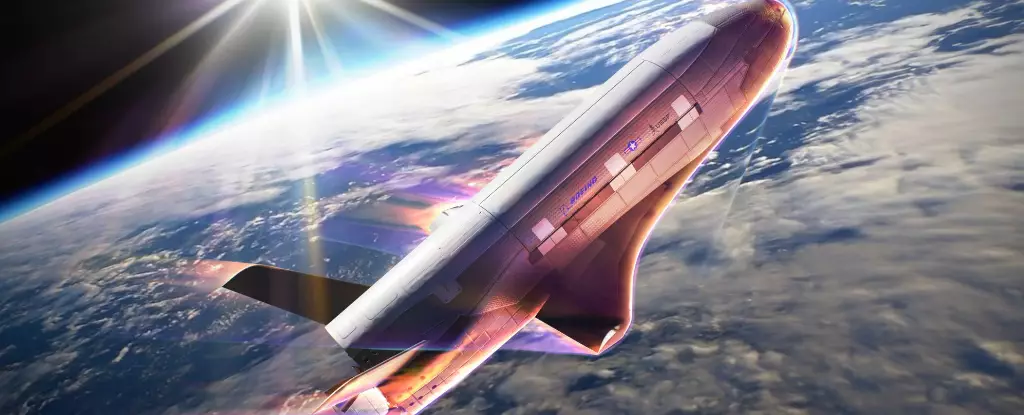Since its initial launch in 2011, the X-37B Orbital Test Vehicle (OTV) has piqued the curiosity of space enthusiasts, scientists, and military strategists alike. Conceived by Boeing and operated by the United States Space Force (USSF), the X-37B is a reusable spacecraft designed for conducting experimental missions at low Earth orbit (LEO), typically between 240 and 800 kilometers above the planet’s surface. While its primary mission involves testing technologies that facilitate future exploration and security in outer space, the full extent of its capabilities remains largely classified and enigmatic. The ongoing secrecy surrounding the vehicle has led to rampant speculation regarding its functions and strategic importance.
On December 29, 2023, the X-37B embarked on its seventh mission, officially designated OTV-7. This latest venture aims to assess the effects of space radiation and evaluate advanced Space Domain Awareness (SDA) technologies. A striking feature of this mission is the planned use of aerobraking— a maneuver that will involve the spacecraft briefly entering the upper layers of Earth’s atmosphere to decelerate and lower its orbit without expending significant fuel. This innovative technique has never before been executed by the X-37B and illustrates the growing sophistication within the framework of its flight capabilities.
Aerobraking represents a strategic advantage, enabling the X-37B to perform undetected reconnaissance operations during low passes over areas of interest. Such capability is particularly relevant in a geopolitical landscape where understanding adversaries’ movements is crucial for national security. USSF officials, including Secretary of the Air Force Frank Kendall and Chief of Space Operations Gen. Chance Saltzman, have highlighted the importance of this maneuver as it not only showcases the Space Force’s commitment to innovation but also underscores the long-standing lessons learned from numerous past missions, including those to the Moon and Mars.
The concept of aerobraking is not new; it has been utilized in various missions throughout the years. Notably, in 1997, the Mars Global Surveyor orbiter demonstrated how solar panels could be employed as wings to facilitate orbital adjustments through Mars’ thin atmosphere. Other successful examples include the Mars Odyssey, the Mars Reconnaissance Orbiter, and the European Space Agency’s ExoMars mission. Such historical usage points to vivid progress in aerodynamics and spacecraft engineering, providing the foundation for what the X-37B now aims to achieve.
One of the most compelling aspects of the X-37B is its ability to orbit Earth in a highly unpredictable manner. As former U.S. Air Force Secretary Heather Wilson pointed out, the X-37B’s unique “egg-shaped” orbital path allows for significant maneuverability, ultimately keeping adversaries guessing about its operational timings. Dr. Jonathan McDowell, an astrophysicist at the Harvard-Smithsonian Center for Astrophysics, elaborated on how this unpredictability could thwart tracking efforts undertaken by rival nations. This orbital novelty marks a vital advancement in space defense strategy, allowing the U.S. to maintain an edge in the evolving domain of outer space.
As the X-37B continues its OTV-7 mission, the focus extends beyond mere observation and data collection. The experiments conducted on this mission include groundbreaking tests involving plant seeds, part of NASA’s “Seeds-2” initiative aimed at understanding how radiation affects biological material. This exploration is critical for future long-duration space missions where food sustainability will be paramount.
Additionally, the X-37B’s commitment to space debris mitigation practices cannot be overstated. As the spacecraft ejects certain service module components in compliance with recognized standards, it demonstrates a proactive approach to tackling one of the most persistent issues in contemporary space exploration—space debris. This practice highlights the unity between ensuring operational success and promoting a sustainable space environment.
The X-37B Orbital Test Vehicle represents a remarkable convergence of military capabilities, innovative technology, and scientific exploration. The spacecraft’s ongoing missions not only serve to test and validate reusable spacecraft technologies but also play a role in shaping the future landscape of military and civilian space operations. As technological advancements continue to unfold, the implications of the X-37B’s capabilities are vast and significant, ensuring that the United States retains its strategic advantage in space. Only time will unveil the full extent of the X-37B’s mysteries and the impacts it will have across various realms of human activity.


Leave a Reply